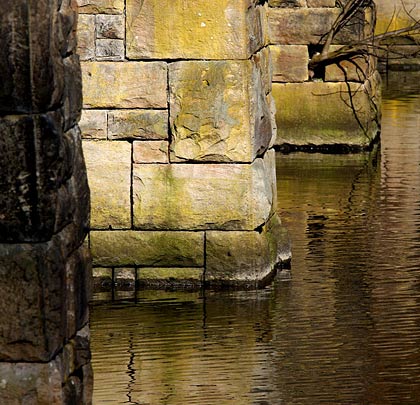Tottington Viaduct
Tottington Viaduct
















Opened by the Bury & Tottington District Railway in 1882, the Holcombe Brook branch was taken over by the Lancashire & Yorkshire Railway after six years’ operation. Steeply graded, it extended for 3¾ miles, incorporating a single track with three intermediate stations; three more were added in 1906.
Preston-based firm Dick Kerr & Co approached the L&Y in 1912 with a proposal to electrify the route – and provide the requisite rolling stock – as part of a proving trial prior to tendering for a contract in Brazil. The trains entered public service on 29th July 1913. The L&Y bought the equipment and stock following successful completion of the tests three years later. During 1917 work began on the branch’s conversion to 1200V third rail, matching the system used between Manchester and Bury, with the new service introduced in March 1918. But by 1951 the equipment was life-expired and, with time running out for the branch, it reverted to steam haulage for its final year of passenger operations. Freight continued to run to Holcombe Brook until 2nd May 1960. Tottington retained its goods service for a further three years.
The route demanded three viaducts to be erected. The biggest, around 125 yards long and comprising nine spans, carried the line over Tottington Mill’s Island Lodge. The piers were built sufficiently wide to allow for a future doubling of the track on the structure’s east side, but this was never deemed necessary.
The viaduct is built entirely in masonry. The piers – rectangular in plan – still host the projecting stones used to support the timber centring, as well as weep pipes. Two courses of tied stones form each of the arches, with large precisely-masoned keystones at their crown. The parapets have rounded copings topped with metal handrails.
Whilst generally in fair condition today, there are many cracks and perished mortar joints resulting in the separation of at least one spandrel face.
In 1972 Tottington Council proposed that the trackbed of the former Holcombe Brook branch should be developed as a 4.5km recreational path, known as the Kirklees Trail. Bury Council acquired a section of it in 1979. The section over the viaduct was improved in 1999 thanks to Countryside Commission funding. 2011-12 saw the Woolfold Gap project implemented at a cost of £1.1 million, resulting in the construction of a new 65-metre viaduct to replace one that had previously been demolished.







